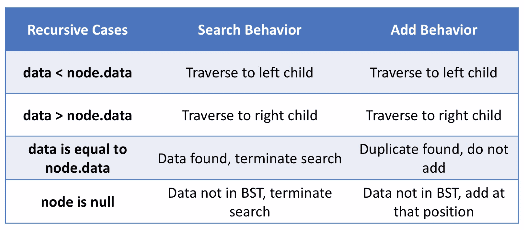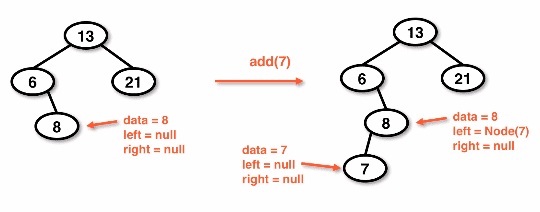adding to a bst
Adding to a BST has similarities to searching; however, if we need to restructure the tree it will be a bit harder than doing a search.
BST search vs. add
The methods for searching and adding are both recursive methods that will search for data via traversal.
- To maintain the structure of a BST we have to add only as leaf nodes
- Insertion into the middle of a tree is very difficult and has no real way to reconcile the structure
- Note: Adding data to an empty tree puts data in at the root
- Data is added at null values so long as it is not already a node
BST search vs add chart:
Adding nodes to a BST example:
- The above example utilizes a recursive search to check each node
Changing the tree structure
When implementing the add method we use pointer reinforcement.
-
Adding a node changes the parent node's left or right pointers, not the node that is being added or removed
-
pointer reinforcement - For each call use the return field to restructure the tree
- Return the node that should be in the direction of traversal
- If you traverse left, return what should be the left child
- If you traverse right, return what should be the right child
- Set left/right pointer to what is returned
- This changes the restructuring to the recursive call of the parent rather than the child
- Return the node that should be in the direction of traversal
-
lookahead method - The recursion is done at one level ahead by keeping track of the parent node rather than the node being added or removed
- This never actually reaches a null node
- It just checks to see if the child in the direction to travel is known or null
- Example: If a child is null, then we can add there
- Works for simple restructuring operations like add, for more complex structures this becomes difficult
Adding to a BST diagram:
Pointer reinforcement
The add() method for a BST using pointer reinforcement is a public wrapper
method that implements a private method. This is used to keep the method from
being changed.
The recursive method checks for 3 cases:
- If the cursor is null
- If the data is less than the current data (go left)
- If the data is greater than the current data (go right)
- Node: When exiting the helpe rmethod once a node is added we return the current node at the end
- This reinforces the pointers that were not changed once the new node is added
Pseudocode for add():
public void add(int data):
root <- rAdd(root, data)
private node rAdd(Node curr, int data):
if curr == null:
size++
return new Node(data)
else if data < curr.data:
curr.left <- rAdd(curr.left, data)
else if data > curr.data:
curr.right <- rAdd(curr.right, data)
return curr


